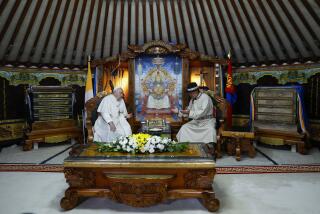New Post in Ulan Bator
- Share via
More than seven centuries ago the Mongol armies of Genghis Khan and his successors began a remarkable and brutal era of conquest that took them first into northern China and ultimately as far west as Poland and Hungary. In the course of these excursions they defeated the knights of Germany, sacked Moscow, forcibly deposited their genetic imprint across a good part of Eastern Europe, and overall made their name a byword for terror and pillage. In time--it is the fate of all empires--the Mongols ended up pretty much back where they started from. In 1691 they were conquered by the Manchurians and their homeland fell under China’s suzerainty. The 1911 revolution in China gave the Mongols the chance to declare their independence. A decade later Soviet troops marched into Mongolia. Three years after that Mongolia became the world’s second Communist state.
The United States has had little to do with Mongolia either before or since then, though on a few occasions it thought that it might try. In 1961 the Kennedy Administration leaked word that it was thinking about establishing diplomatic relations with Mongolia--an idea quickly set aside after it elicited strong protests from those who saw no value in recognizing the legitimacy of any Communist regime. In the early 1970s the Nixon Administration, on its way to normalizing relations with China, came very close so setting up diplomatic ties with the government in Ulan Bator. That, too, fell through--possibly because of Soviet pressures on Mongolia, possibly because of complaints from Taiwan (whose Nationalist government had earlier recognized Mongolia’s independence but later changed its mind), possibly for both reasons.
Now, with little fanfare and no discernible protests, the United States and Mongolia have agreed to formal diplomatic relations. The action obviously has Soviet approval, and almost certainly acquiescence as well from Peking, which itself recognized Mongolia’s independence in 1950. The move follows by a few weeks the Soviet Union’s announcement that it is withdrawing up to 11,000 of the estimated 75,000 troops that it stations in Mongolia. Mongolia has always sided with the Soviet Union in its ideological and national confrontation with China. The troop withdrawal is seen as a gesture by the Soviets to improve their relations with China.
The American ambassador to Ulan Bator will not be residing in one of the world’s livelier diplomatic posts. Landlocked Mongolia, cradled between the Soviet Union and China, is slightly larger than Alaska but home to only about 1.9 million people. Essentially a pastoral country, though with industrialization said to be proceeding at a fairly rapid pace, the bulk of Mongolia’s wealth is still to be found in vast herds of sheep, goats, horses, cows and camels. Last year Mongolia attracted about 10,000 tourists. Americans who might be interested in visiting one of the world’s oldest countries will find that they can exchange each dollar for 3.55 tugriks. For those in need of small change, there are 100 mongo to the tugrik.
More to Read
Sign up for Essential California
The most important California stories and recommendations in your inbox every morning.
You may occasionally receive promotional content from the Los Angeles Times.













